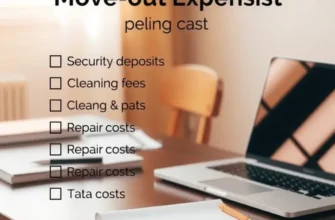As young professionals, students, and families settle into new living arrangements, the topic of security deposits often turns into a frustrating source of confusion. You’ve paid your hard-earned money to secure your lease, believing your deposit is a safety net for your landlord. But when it comes time to move out, discrepancies may arise—deductions that seem unjustified can lead to financial headaches and stress. Understanding your rights and knowing how to dispute these deductions can save you both money and peace of mind. The goal here is to navigate through this process with clarity, providing you with practical strategies to contest any security deposit deductions you believe to be unfair. With the right information and a little advocacy, you can reclaim your deposit while also learning the best practices for your rental experience. Let’s dive into how to approach this issue step-by-step.
Understanding Your Lease and State Laws

Familiarizing yourself with your lease agreement is an essential first step in safeguarding your security deposit. Begin by reviewing your lease in detail. Look for sections that relate to maintenance responsibilities, deposit withholding, and any clauses about repairs and cleanliness. These provisions will guide you in understanding what constitutes fair and unfair deductions.
When dissecting your lease, pay particular attention to specific terms regarding the move-out procedure. Some leases stipulate that the property must be professionally cleaned, while others might require ordinary cleaning. Document any ambiguous language and seek clarification from your landlord if necessary. Keep a copy of any corollary communication as evidence of good-faith efforts to comply.
In addition to understanding your lease, familiarize yourself with local rental laws. Each state has unique regulations governing the treatment of security deposits. Some states mandate that landlords must return the deposit within a specified period after the lease ends, often 30 days, unless reasonable deductions are made for unpaid rent or damages beyond normal wear and tear.
Normal wear and tear can be a contentious issue, often causing disputes between tenants and landlords. An understanding of local definitions can help you evaluate whether the claimed damages are justified. For example, minor carpet wear, small nail holes, or slight wall discoloration typically fall under normal wear. Extensive damage, such as large holes, stained carpets, or any alteration without permission, might not.
Your state’s tenant rights laws may also require landlords to provide itemized lists of deductions, including costs incurred for repairs. Familiarize yourself with these mandates to ensure compliance from your landlord. Furthermore, some states provide legal recourse for tenants, including penalties against landlords who wrongfully withhold deposits.
To ensure compliance with both lease and law, document the condition of the property meticulously upon moving in. Take photos and make notes of existing damages or issues, and share these with your landlord. Upon moving out, repeat the process. A documented before-and-after comparison serves as crucial evidence to dispute any unwarranted deductions.
A potential resource for additional guidance could be financial planning tools specifically for renters. These can provide insight into managing rental expenses and preventing disputes that affect your credit score. For more tips on financial management as a renter, consider exploring articles like financial planning for renters.
By thoroughly understanding your lease and state laws regarding security deposits, you empower yourself with the knowledge necessary to protect your financial investment in your rental property.
Building Your Case for Dispute

When confronting unexpected deductions from your security deposit, treat the process like a small legal case. Start by methodically gathering evidence that counters the landlord’s claims. Your efforts can significantly boost your chances of receiving a full refund.
Begin by retrieving the original signed lease agreement, focusing on sections that detail the condition and expectations upon moving out. Make digital copies of these essential pages for easy sharing later on. Next, locate any move-in checklist you completed, as it serves as a baseline for the apartment’s condition when you took possession.
Conduct a thorough inspection of the apartment before moving out. Take high-resolution photos or videos that capture each room’s state. Be meticulous, and include timestamps on all images if possible. For areas you suspect might be controversially assessed, capture close-ups showing no apparent damage. This visual documentation will be pivotal should your landlord present a contrary narrative.
Document any repairs or upgrades you implemented, especially if they improved the unit’s condition. Often landlords overlook tenant-led enhancements unless properly notified in advance. Similarly, collect all interaction records with your landlord or maintenance personnel discussing repairs or issues during your stay. These communications can support arguments about pre-existing conditions often blamed on the last tenant.
Compiling your case also benefits from dispute communication templates. Begin drafting a formal letter or email to present your dispute clearly and respectfully. Structure it so: a brief introduction, a detailed outline of each deduction being contested, and supporting evidence for each claim. Attach relevant documentation but avoid overwhelming your landlord with excessive paperwork. Highlight the most compelling evidence.
Set clear timelines for each step in your dispute process. Note any contractual stipulations about deposit return periods and response windows for disputes. Be prepared to gently remind, rather than pressure, your landlord of missed deadlines, ensuring you remain polite yet persistent. Keep efforts professional, avoiding emotional pleas, which often detract from the evidence-based approach required here.
In resolving rental deductions, sometimes additional assistance helps. Options like mediation can provide unbiased ground for both parties. Consider professional support if your initial efforts find no traction, though ensuring cost-effectiveness remains crucial.
For first-time renters diving into dispute procedures, understanding this landscape is vital. Explore further guidance on related issues, such as resolving rental billing errors, which might offer additional insights into negotiation processes and preserving your financial interests.
Approaching disputes with evidence and calm persistence not only increases deposit recovery potential but also enhances tenant empowerment. Building a clear, concise, and documented case positions you well in any negotiation, reflecting your commitment to fairness and rights as a renter.
Final words
In navigating the complexities of security deposit deductions, the key lies in understanding your rights and protecting your interests. Knowing how to effectively dispute any unjust deductions can not only alleviate financial strain but also empower you as a renter. Remember, clear communication with your landlord and meticulous documentation are your best allies in this process. Don’t hesitate to stand up for what’s fair and reclaim your hard-earned money. Equip yourself with the knowledge and confidence to tackle this aspect of renting head-on, ensuring your next move is stress-free and financially sound.









